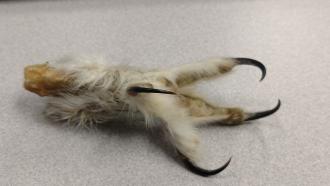Getting Our Students Outside
Submitted by Duane Shreve on Thu, 2017-07-13 00:00
This has been a topic we I have discussed with several of my colleagues this week. We have all seen our students becoming more entrenched with their X-Box 360 and assorted video games rather than spending time playing outside. I feel this is a mind set that starts at home. If a familiy isn't inclined to be active outdoors then the students won't feel the need to be outside. We as teachers can only do so much to convince our students that there is far more to gain by being outside than being stuck to a couch playing video games, but this doesn't mean we shouldn't try.
We are quite a diverse group, age wise, this week and I am pleased to see several second year teachers in the group. I feel they will have a lot of impact on their students during their careers and since they are here they must feel a connection to our natural environmnet. They can transfer this connection to their students through lessons and general comments during the school year. Of course, even older teachers, such as myself, can do this, but having connection to the outside coming from a younger teacher can have a larger impact.
We discussed the importance of the level of impact of the lesson being taught. Does every lesson have to deal with issues that are sensational and riveting? Global warming for instance has had a lot of press over the last several years. The general concesus is that any lesson dealing with our environment is important. The key to this isn't the level of impact but how the kids can relate to the lesson. Something as simple as the school garden at Roosevelt Elementary can stay with a student for years. Teachers too for that matter.
My question for you: Working with students with diverse academic backgrounds can be challenging, as we all know, but what about creating an environmental lesson for a group of students that never visit the "outdoors?" Where would you start and what would lesson be directed toward?


Comments
Get Outside
I read an article that some inmate's spend more time a day outsise than our students! I am constantly trying to get my students excited about Idaho. We live in the perfect clumat (maybe not today 104 degrees). I am sad how many have never been to the Greenbelt, Table Rock, or Reserve....we need this generation to help us preserve or it will be lost to developers.
Hi Monica,
Hif Monica,
That is very disappointing article. We, as parents and teachers sometimes don't recognize the importance of spending time in nature. Time spent outside has revitalizing powers that can't be duplicated inside. A quick walk, a jog, a little time spent playing with friends or pets can do so much to help a child relax. Of course, these activities are done at home, but at school a little time could be taken to walk around the perimeter of the school picking up litter. The kids may not like this as much as go noodle ( a computer generated activity time) but it can turn into a lesson on the environment. I'm going to do this next year and I bet it will be a segway into a more vital lesson about the environment.
Take time for lessons outdoors
We are fortunate that our middle school has a nice campus for outdoor lessons. Our campus includes a mini-forest of evergreens and several areas of woods with deciduous trees. We have a dirt trail system that connects with ISU's dirt trail system for x-country walking/trekking/running. Within a short walk is a frisbee golf course with dirt trails working up a hillside. I am excited that land has been granted for a plan in the works for a park near campus too. This park, dedicated to veterans, is to have physical obstacles along trails in a boot camp fashion (think climbing walls, ropes, etc). As a PE teacher, I spend as much time as I can outdoors with my students. However, many of my colleagues also spend time outside. Our honors English teachers brought kids outside this winter to sled on our campus hill and then had the students compose a 5 senses writing reflecting on the experience. Our sciene teachers create and launch rockets on campus. Our health teachers incorporte walking and heart rate lessons on our track. Our science teachers have students photograph and record weather and cloud patterns for weather journals. Our math teachers come outside for measuring and distance lessons. Our DLP classroom comes outside to interact with dog trainers that come to campus and run their dogs through obstacles (jumps and tunnels). Our geography teacher brings his class out often just to walk for 10 minutes to get the wiggles out. Our art teacher, who was also an in-person learner with me in June, plans to incorporate more earthworks in his lessons this coming school year. Our recycling class and PE classes do daily litter pick ups campus-wide outdoors (kids leave trash after lunch recesses on the football field). There are so many manners in which to incorporate a little time outside with any subject matter.
Nature notebooking or nature journaling is a popular concept amongst naturalists and homeschooling circles. Check it out! You can google "nature notebooking" or "nature journaling" or "Charlotte Mason nature study" for beginning resources. I'll link a few of my favorite titles that I used while I homeschooled my own children pre-k through grade 4. Nature notebooking can be worked into any subject...ELA, math, science, art, etc. Kids these days are very adept at capturing what they see through the lens of a cell phone, but nature notebooking takes them back to recording what they see and reflecting upon it through pencil and paper (greater brain connections made to subject matter when sketching what one sees). A simple art lesson may be heading outside to collect a stone and sitting and sketching the stone first with eyes closed and then again with eyes open. A science study of sketching clouds and keeping a weather journal is an option. Sketching the same tree over the seasons helps recognize seasonal changes. Observing nature on campus and writing a haiku can fit ELA. Sketching a spider web can incorporate a unit study on insects. Sketching contaminents in a rain puddle can lead to social science discussions on pollution and storm water quality. Creating a map of campus could fit geography lessons.
I'm a huge proponent of getting kids out of their desks and outside, even if it's once a trimester. I have also purchased Richard Louv's book titles to read this summer. They have been on my TBR list (to be read) for years. My in-person adventurer experience has renewed my interest in reading his books ("The Nature Principle," "Last Child in the Woods," and "Vitamin N: The Essential Guide to a Nature Rich Life"). I'll link those titles as well.
Darcy, I am thrilled that
Darcy, I am thrilled that your school has the facilities you mentioned. Obviously, in your school the environment is an important issue. And thanks for all the resources.
Get them OUT!
Duane,
I could not agree more that our students need to spend more time outdoors. I moved to Idaho almost 2 years ago and am currently starting my 3rd year of teaching. In my free time I spend as much time as possible outside doing some sort of activity whether that is hiking, running, biking, rock climbing, skiing, etc. Being active in the outdoors is a HUGE part of my life. However, I have a really hard time integrating this into my classroom. It was really nice to read Darcy's post about her school and all the teachers that are taking their students outside to do various projects. Lot's of my students are not used to spending their time outdoors and being active unless it is on the sports field. I wonder how I could implement a healthy and active outdoor lifestyle into my classroom. Any and ALL ideas are welcome!
Hi Shannon,
Hi Shannon,
I am like you, being outdoors is also a huge part of my life and as I've talked about my favorite activiies, with my students, these discussions become impromptu lessons about our environment. I fully believe that any exposure to the concerns we face the better off the kids are. This may be a five minute talk about the waterways in Bosie and how the fish are affected to a 30 minute lesson about the removal of water from the Colorado River for irrigation purposes. There is never too little when it comes to awareness of our environment.
If the area you moved from is different from where you live now, for instance forested vs. high desert you could bring pictures in. This would help build a relationship between you and the students and you could help them become aware of the differences between your old habitat and new. I bet they would get a kick out of hearing stories about your experiences. The hard part is limiting them, time wise.
Outside for Homework
You all made really great points! Next year I'm going to try having students take pictures of their outdoor experiences that relate to our units. For example, we learn about all the different types of weathering, so students will then have to go out and find examples. I always debate whether this is fair or not since not all students have the same resources, but as long as I can provide a camera of some sort, I think every student should be able to take a picture of their examples. I know some students will have access to more remote places, but plant roots breaking up the sidewalk or rocks can be seen everywhere in Boise. And ice wedging was happening everywhere last winter! :O) Thanks for the great ideas!
Hi Denise, I really like this
Hi Denise, I really like this idea. They can become familiar with technology at the same time. Although, most of my students are miles ahead of me on the technology front.
Getting Students Outside
It never ceases to amaze me how few of my students spend time in the outdoors. As an adult I'll admit I don't get out as often as I should but when I was the age my students are I was constantly outside! It can be difficult to get kids outside during the school day especially since I always seem to equate it with more planning and preparation than a lesson held indoors (I know this is not always the case however). One thing a few teachers and I began doing this spring was just taking the kids outside for 30 minutes of walking the track. The only two requirements were that they could not have electronics out and they had to be moving. The students dragged their feet at first but it turned into a truly positive experience and one we will continue doing next year.
Casey, that is a great start.
Casey, that is a great start. They could bring a paper and pencil with them divided into two columns which are titled human and natural references. We used this paper today during a field trip around Eagle Island State Park. I felt it was a great way to see how both are related and work in conjunction with each other. We didn't get too detailed in identifying species of trees, grasses, or animals so it would not be too difficult for any age of student.